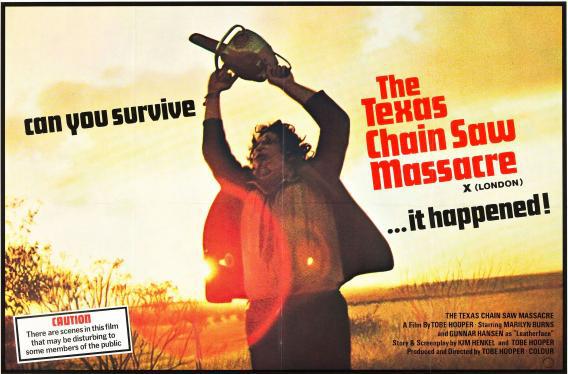While the new documentary Blackfish has animal welfare issues back in the headlines, a recent video essay prompted me to take a look at a film that I never thought of as the least bit friendly to vegetarians: The Texas Chain Saw Massacre. The short, three-minute YouTube video argues that the movie shows the horrors of industrial agriculture by turning our world upside-down, and putting humans in the position of being slaughtered like farm animals.
The essay is by Rob Ager, whose theories about the hidden meanings of classic films, often based on the most minute details, can frequently feel a bit batty. But here I think he stands on solid ground. In fact, at times the theme seems so forehead-slappingly obvious that I was initially surprised that it’s not more widely discussed. The details that suggest it, after all, are not so minute. (Note: The video below is a bit gory.)
As we learn early on, the movie’s killers, the murderous Sawyer family (comprised of Leatherface, Grandpa, et al), used to run a slaughterhouse, and the means they use to slaughter their victims are the same as those used to slaughter cattle. They knock them over the head with sledgehammers, hang them on meat hooks, and stuff them into freezers. Often this takes place as the victims are surrounded by animal bones, a detail that could be explained away as the evidence of their former occupation—except that the cries of farm animals (there are none around) are played over the scenes.
Eventually we learn the killers’ motives: They slaughter for meat. When they sit down to dinner, they mock their final surviving victim by making animal noises at her, and forcing her to watch them eat what we can only guess are the remains of her friends. All while several of them don human skins, to match the leathers hanging around the house.
Toward the beginning of the film, to set all this up, the character Franklin (an eventual victim) describes in horrifying detail how animals are killed. Everything he describes soon happens to the Sawyers’ victims:
They bash ’em in the head with a big sledgehammer. It usually wouldn’t kill on the first click. … They’d start squealing and freaking out and everything, and they’d have to come up and bash them two or three times. And then sometimes it wouldn’t kill ’em. I mean they’d skin ’em sometimes before they were even dead.
One of his friends responds, “Well, that’s horrible. People shouldn’t kill animals for food.”
Though this aspect of the film hasn’t made its way into discussions of the movie in the mainstream media, it hasn’t been lost on everyone. Instead, to find any mention of the subtext, you have to turn to organizations like People for the Ethical Treatment of Animals (PETA), which lists The Texas Chain Saw Massacre as one of the “Top 10 Movies That Make You Go Meatless.” (In accordance with PETA’s M.O., it cites a celebrity vegan, hip-hop mogul Russell Simmons, who calls it a “vegetarian” movie: “The way that woman was screaming, ‘Aaaahhh,’ and she’s running away,” he says, “that’s how every animal you eat is running for his or her life.”) PETA even recommends the once controversial film as one of the best movies for vegetarian activists to show on campus, while another fan calls it “the greatest pro-vegetarian movie of all-time.”
Why haven’t more people written about this theme in the film? It’s not as if the movie hasn’t been the subject of close analysis. And once you begin to see the theme it is about as subtle as Leatherface’s sledgehammer. But it sneaks up on you because it’s also there to serve the film’s more explicit purpose: to terrify. In that light, all the early talk of slaughterhouses can just seem like foreshadowing.
But to terrify is not all director Tobe Hooper meant to achieve. Hooper has all but confirmed that he made Chain Saw in part to be the “Meat Is Murder” of movies, stating multiple times that “it’s a film about meat.” (He’s also offered some support for Ager’s reading of the movie as a world turned upside-down: He’s described the Sawyers as “people going beyond the line between animal and human.”) In a rare interview in which he was asked point-blank whether the movie was “vegetarian propaganda,” Hooper said:
I gave up meat while making that film. In a way I thought the heart of the film was about meat; it’s about the chain of life and killing sentient beings, and it has cannibalism in it, although you have to come to that conclusion by yourself because it’s only implied. Guillermo Del Toro also gave up eating meat after seeing that movie.
Of course, a bloody horror movie is the last place you’d look to find a “vegetarian” movie, but the fact that so few viewers know about the message going in could make it all the more effective—it’s not just preaching to the converted. After all, most of us would prefer to be naïve to the suffering that goes into our meat. To be like the vacationers when, early on, they stop to buy some sausage from one of the Sawyers, but have no idea how it got there. To be like Sally, who tells her friend, “Franklin, I like meat. Please change the subject!”
